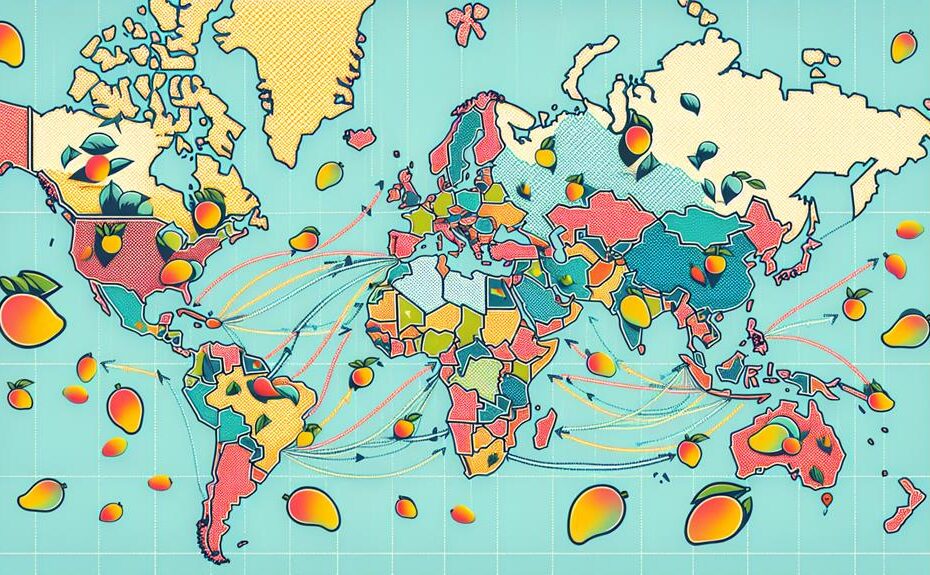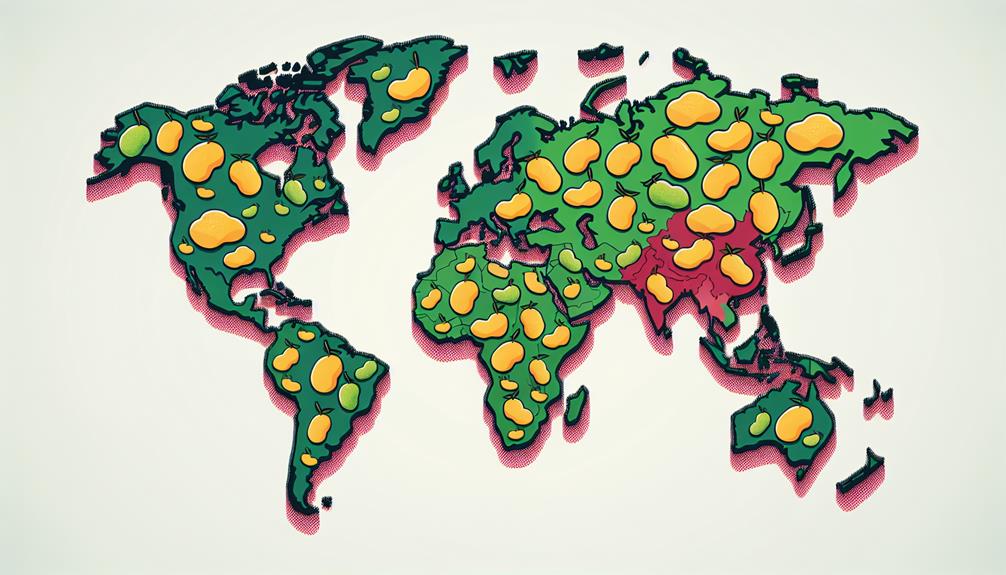As you consider the complexities of the mango trade on a global scale, it becomes evident that major exporters and importers play pivotal roles in shaping market dynamics. Understanding the strategic decisions made by countries like India, Mexico, and the United States in the mango trade can provide valuable insights into the factors influencing supply chains, pricing structures, and consumer preferences. Stay tuned to discover the intricate web of relationships and trends that drive the mango trade landscape, offering a glimpse into the fascinating world of international fruit commerce.
Key Takeaways
- Top mango exporters invest in sustainable cultivation techniques and advanced processing technologies.
- Leading importers like the US, Netherlands, and Germany drive market trends and pricing dynamics.
- Market diversification strategies and quality standards are crucial for exporters and importers.
- Strategic partnerships and consumer demand influence mango trade globally.
- Import volumes from key countries impact mango market dynamics significantly.
Global Mango Trade Overview
The global mango trade exhibits dynamic patterns influenced by various factors such as climate conditions, consumer demand, and trade agreements. Mango cultivation techniques play an essential role in determining market prices. Countries employing sustainable farming practices often have a competitive edge due to the increasing demand for organically grown fruits driven by consumer preferences for healthier and environmentally friendly options.
In recent years, the trend towards sustainable farming practices has gained momentum in the mango industry. This shift is not only driven by consumer preferences but also by regulations pushing for environmentally responsible agricultural methods. As a result, many mango-producing regions are adapting their cultivation techniques to align with these practices, impacting market prices and trade dynamics.
Understanding consumer preferences for sustainably sourced mangoes is pivotal for stakeholders in the global mango trade. By incorporating eco-friendly practices into mango cultivation and production, exporters can potentially capture a larger market share and command premium prices in line with changing consumer demands.
Top Mango Exporters
Among the leading exporters of mangoes globally, several countries stand out for their significant contributions to the mango trade. These countries have gained prominence through their advanced mango cultivation techniques, meeting the increasing global demand for this popular fruit. Additionally, their adoption of innovative mango processing technologies has allowed them to stay competitive in a market with high demands for quality and efficiency.
Here are four key factors that have contributed to these countries' success in mango exports:
- Investment in Sustainable Cultivation: These top exporters have focused on sustainable mango cultivation techniques to guarantee a consistent supply of high-quality mangoes.
- Adoption of Advanced Processing Technologies: By investing in cutting-edge mango processing technologies, these countries have been able to meet stringent quality standards and enhance the shelf life of their mango products.
- Market Diversification Strategies: To stay ahead in the face of market competition, these countries have diversified their export destinations, reducing reliance on any single market.
- Strategic Partnerships: Forming strategic partnerships with key players in the mango industry has enabled these countries to access new markets and distribution channels, further boosting their export volumes.
Leading Mango Importers
Having analyzed global mango trade data, it is evident that a select group of countries emerge as the leading mango importers in the international market. When it comes to mango consumption, these nations play a noteworthy role in satisfying the demand for this tropical fruit. Additionally, mango pricing dynamics are influenced by the import volumes of these countries, impacting the overall market trends.
Below is a table showcasing the leading mango importers based on recent data:
| Country | Mango Import Volume (tons) | Main Mango Suppliers |
|---|---|---|
| United States | 1,200,000 | Mexico, Peru |
| Netherlands | 900,000 | Ecuador, Peru |
| Germany | 800,000 | Spain, Israel |
| UK | 700,000 | India, Pakistan |
| France | 600,000 | Ivory Coast, Peru |
The data illustrates the substantial mango import volumes of these countries, highlighting their importance in the global mango market. Their consumption levels and pricing strategies significantly impact the industry dynamics.
Mango Trade Trends Analysis
Analyzing recent market data reveals compelling trends in the global mango trade landscape, shedding light on consumption patterns and pricing dynamics.
- Demand Analysis: The demand for mangoes has shown a steady increase in key markets such as the United States, Europe, and Asia. Factors such as the growing popularity of healthy eating habits and the versatile use of mangoes in various cuisines have contributed to this rise in demand.
- Price Fluctuations: Price fluctuations in the mango trade have been influenced by various factors like weather conditions affecting harvest yields, transportation costs, and currency exchange rates. These fluctuations impact both exporters and importers, requiring them to adapt their pricing strategies accordingly.
- Regional Consumption Patterns: Different regions exhibit distinct consumption patterns, with some preferring fresh mangoes while others opt for processed mango products like juices and dried slices. Understanding these regional preferences is essential for traders to cater to diverse markets effectively.
- Sustainability Initiatives: There is a growing trend towards sustainably sourced mangoes, with consumers showing a preference for ethically produced fruit. This has led to an increase in certifications and initiatives promoting sustainable mango trade practices.
Challenges in Mango Trade
The mango trade faces substantial challenges stemming from market volatility, supply chain complexities, and evolving consumer preferences. Supply chain inefficiencies can result in delays, leading to increased transportation costs and potential spoilage of perishable mangoes. This underscores the need for streamlined logistics and improved coordination among producers, exporters, and importers.
Tariff barriers also pose a major challenge in mango trade. High tariffs imposed by certain countries can greatly impact the competitiveness of mango exporters, making it challenging for them to access key markets. This can impede trade flow and limit market expansion opportunities for both exporters and importers.
To overcome these challenges, stakeholders in the mango trade must work towards enhancing supply chain efficiency, exploring trade agreements to reduce tariff barriers, and adapting to changing consumer preferences by offering diverse mango varieties and value-added products. By addressing these challenges strategically, the mango trade can navigate market complexities and foster sustainable growth in the global marketplace.
Asia-Pacific Mango Market
The Asia-Pacific mango market exhibits dynamic trends driven by varying levels of production, consumption, and trade within the region. When analyzing this market, several key factors come into play:
- Market Competition: The Asia-Pacific region sees intense competition among mango producers, with countries like India, the Philippines, and Thailand vying for market share through quality differentiation and pricing strategies.
- Pricing Strategies: In the Asia-Pacific mango market, pricing strategies play an essential role in determining consumer demand and overall profitability for growers and exporters. Understanding local market dynamics is vital for setting competitive prices.
- Supply Chain: The efficiency of the mango supply chain in the Asia-Pacific region significantly impacts the quality and freshness of the fruit reaching consumers. Streamlining logistics and reducing post-harvest losses are key focus areas for industry players.
- Distribution Channels: From traditional markets to supermarkets and online platforms, diversified distribution channels in the Asia-Pacific mango market cater to a wide range of consumer preferences, influencing accessibility and sales volume. Optimizing distribution networks is vital for reaching diverse consumer segments effectively.
European Mango Trade Dynamics
Market dynamics in the European mango trade reveal distinctive patterns influenced by factors such as import regulations, consumer preferences, and seasonal fluctuations in supply. The European market dynamics for mangoes are heavily impacted by trade regulations and tariffs imposed on imported fruits. These regulations can affect the volume of mangoes entering the European market and subsequently influence prices and availability for consumers. Additionally, consumer preferences play a significant role in shaping the demand for different varieties of mangoes in Europe, with preferences varying across different regions.
| Country | Mango Imports (in tons) | Main Suppliers | Trade Regulations |
|---|---|---|---|
| Germany | 250,000 | Spain, Israel, Peru | Moderate tariffs |
| France | 180,000 | Ivory Coast, Brazil | Strict phytosanitary rules |
| United Kingdom | 160,000 | India, Pakistan, Brazil | Preference for organic |
| Netherlands | 140,000 | Egypt, Brazil, Peru | Relaxed import regulations |
Understanding these dynamics is essential for stakeholders in the European mango trade to navigate market complexities and make informed decisions.
North American Mango Industry
How does the North American mango industry compare to its European counterpart regarding trade dynamics and market trends? The North American mango industry showcases a unique set of characteristics that differentiate it from the European market. North America is known for producing a variety of mangoes, including popular varieties such as Tommy Atkins, Ataulfo, and Kent. In terms of farming techniques, North American mango farmers often employ advanced methods to ensure high-quality produce, such as controlled irrigation systems and integrated pest management strategies.
Markdown List:
- Diversity of Varieties: North America boasts a wide range of mango varieties, appealing to diverse consumer preferences.
- Sustainable Farming Practices: Mango farming in North America is increasingly adopting sustainable techniques to minimize environmental impact.
- Market Penetration: The North American mango industry has been successful in penetrating domestic markets, leading to increased consumption.
- Quality Standards: North American mango producers adhere to stringent quality standards to maintain competitiveness in the global market.
South American Mango Market
Comparing the North American mango industry to its European counterpart highlights distinct trade dynamics and market trends; now, shifting focus to the South American Mango Market reveals a region characterized by diverse cultivation practices and export strategies. South America is renowned for its wide array of mango varieties, including the popular Tommy Atkins, Kent, and Ataulfo mangos. These varieties thrive in the region's varied climates, from the tropical forests of Brazil to the arid landscapes of Peru.
Mango production techniques in South America vary depending on the country and climate. In Brazil, the largest mango producer in the region, a combination of traditional farming methods and modern technology is utilized to guarantee high yields and quality fruit. On the other hand, countries like Ecuador focus on organic farming practices to cater to the growing demand for sustainably produced mangoes in international markets.
African Mango Trade Insights
African mango trade dynamics exhibit a unique blend of traditional cultivation methods and emerging export strategies in the global market. The continent's rich agricultural heritage and diverse climatic conditions contribute to the cultivation of various mango varieties, making it a significant player in the mango trade landscape. Here are some key insights into African mango trade:
- Mango Cultivation Practices: African countries employ a mix of traditional and modern cultivation techniques, enhancing productivity and quality.
- Varieties: Africa is home to a wide range of mango varieties, including Kent, Keitt, Tommy Atkins, and Haden, each with unique flavor profiles and characteristics.
- Export Trends: The African mango trade has been witnessing a steady increase in exports to international markets, driven by growing demand for exotic fruits.
- Challenges and Opportunities: While African mango trade faces challenges such as infrastructure limitations and post-harvest losses, there are opportunities for expansion through value-added processing and strategic partnerships.
Oceania's Mango Trade Scenario
With a growing demand for tropical fruits in international markets, Oceania's mango trade landscape is undergoing notable shifts in production and export dynamics. Mango production in Oceania is primarily concentrated in Australia and Papua New Guinea, with Australia being the largest producer in the region. The supply chain for mangoes in Oceania is well-established, ensuring efficient harvesting, processing, and distribution to meet both domestic and export demands.
On the consumption front, Oceania's mango market is experiencing steady growth due to the increasing popularity of mangoes among consumers for their flavor and nutritional benefits. The demand for Oceania's mangoes is not only strong locally but also in international markets like Asia and Europe, where these tropical fruits are highly prized.
| Mango Trade Statistics | Data |
|---|---|
| Top Mango Producer | Australia |
| Major Export Destinations | Asia, Europe |
| Domestic Consumption | Increasing |
| Export Growth Rate | Steady |
Middle East Mango Market Trends
In the Middle East, mango market trends are reflecting a notable shift towards increased consumption and import of this tropical fruit. Middle East mango consumption has been steadily rising due to changing consumer preferences and a growing awareness of the fruit's health benefits. Market dynamics indicate a surge in demand for premium mango varieties, leading to higher import volumes from countries like India, Pakistan, and the Philippines. However, this trend also poses challenges such as ensuring consistent supply to meet the escalating demand and maintaining fruit quality standards throughout the supply chain. Additionally, fluctuations in weather patterns and natural disasters in key mango-producing regions can impact the market by affecting harvests and causing price volatility. To sustain this upward trajectory in Middle East mango consumption, stakeholders need to address these challenges proactively and work towards establishing resilient supply chains and efficient distribution networks to meet the region's growing appetite for mangos.
Future Outlook for Mango Trade
Amidst evolving global trade dynamics, the future outlook for mango trade is characterized by a growing emphasis on sustainable practices and innovative market strategies to meet increasing demand and tackle emerging challenges. Market projections indicate a steady rise in mango trade volume, driven by the growing popularity of this tropical fruit in various regions worldwide. Trade regulations are expected to play an essential role in shaping the future landscape of mango trade, ensuring fair practices and quality standards across borders.
| Key Factors | Impact on Mango Trade |
|---|---|
| Sustainability Practices | Increasing consumer demand for ethically sourced and environmentally friendly products is pushing the mango industry towards sustainable farming practices and certifications. |
| Technological Advancements | Adoption of advanced technologies such as IoT for precision agriculture, blockchain for supply chain transparency, and AI for yield optimization is set to revolutionize mango production, quality control, and distribution processes. |
Frequently Asked Questions
How Does Climate Change Impact Mango Trade?
Climate change affects mango trade by causing disruptions in the supply chain due to extreme weather events. Market demand for mangoes fluctuates as changing climates impact harvest yields and quality, influencing trade dynamics globally.
What Are the Most Popular Mango Varieties for Export?
For export, the most popular mango varieties are those with a perfect balance of sweetness and tanginess, such as Alphonso, Kent, and Tommy Atkins. Market demand trends show a preference for these mango flavor profiles.
Are There Any Regulations on Mango Trade for Sustainability?
Regulations on mango trade for sustainability are essential. Market trends emphasize eco-friendly practices. Global impact drives the need for responsible sourcing. Stay informed to navigate the evolving landscape and contribute to a sustainable mango market.
How Do Currency Exchange Rates Affect Mango Import/Export Prices?
Currency exchange rates directly impact mango import/export prices. Fluctuations can lead to cost variations, affecting competitiveness and profit margins. Tariffs and supply chain disruptions exacerbate these effects, necessitating strategic planning and risk management to navigate the challenges effectively.
What Role Do Technological Advancements Play in Mango Trade Efficiency?
In mango trade, technological advancements are pivotal. Supply chain efficiency is bolstered through data analytics, streamlining processes from cultivation to consumer shelves. Real-time insights optimize distribution, reduce waste, and enhance overall trade effectiveness.


